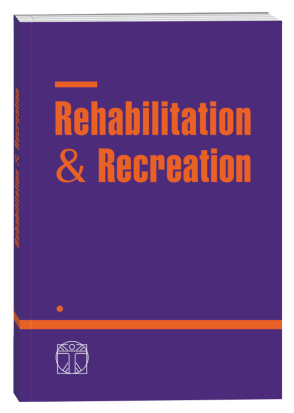CORRECTION OF FUNCTIONAL SYMPTOMS OF CHANGES IN THE MOVEMENT PATTERN OF THE LOWER EXTREMITY IN ELDERLY PATIENTS WITH KNEE JOINT ENDOPROSTHESIS IN THE REMOTE POSTOPERATIVE PERIOD BY PHYSICAL THERAPY
DOI:
https://doi.org/10.32782/2522-1795.2023.15.13Keywords:
rehabilitation, senile asthenia, geriatrics, endoprosthesis of lower limb joints.Abstract
Purpose: to assess the effectiveness of the developed physical therapy program on the parameters of functional symptoms and changes in the movement pattern of the lower limb in elderly patients with knee arthroplasty in the remote period after surgical intervention. Methods. 80 elderly people were examined. The control group consisted of 24 people without joint endoprostheses, with no signs of sarcopenia. The comparison group consisted of individuals with knee arthroplasty and sarcopenia with low rehabilitation compliance with regard to active rehabilitation intervention. Representatives of the main group with knee endoprosthesis and sarcopenia practiced according to a developed program of physical therapy, created taking into account the specifics of each comorbid condition. The program lasted 6 months; contained the following elements: therapeutic exercises, functional training, massage, kinesiotaping; dietary recommendations; patient education. The effectiveness of the program was evaluated according to the dynamics of Forgotten Joint Score-12, Knee Society Score, goniometry of the knee joint, manual muscle testing of the thigh muscles. Results. In elderly patients with knee endoprosthesis and sarcopenia, functional symptoms of changes in the movement pattern of the lower limb in the form of a violation of the structural and functional state of the knee joint, joint contracture, and a decrease in the strength of the hip muscle groups were revealed. The developed physical therapy program revealed a statistical improvement in the condition of patients due to the influence on the components of the movement pattern of the knee joint due to the improvement of the functional state of the knee joint, improvement of its flexibility, strength of the thigh muscles, reduction of pain in comparison with the initial indicators for all the studied parameters (р<0 .05); however, the indicators of the control group were not reached (p>0.05). Low rehabilitation compliance of patients in the comparison group, despite being aware of the risks of polymorbidity, was associated with a lack of improvement over a similar follow-up period. Conclusions. Elderly patients with the consequences of total knee arthroplasty and sarcopenia require the development of physical therapy programs taking into account and correcting the specifics of each condition, the presence of physical status disorders and the risk of falling, which will increase the overall effectiveness of rehabilitation measures.
References
Дідоха І.В., Аравіцька М.Г. Вплив засобів фізичної терапії на рівень кінезіофобії, соматичні маркери саркопенії та показники ризику падіння у осіб похилого віку з хворобою Паркінсона. Art of Medicine. 2021. 2 (18). С. 50-58. DOI: 10.21802/artm.2021.2.18.50
Коваль Н.П., Аравіцька М.Г. Ефективність корекції показників ризику падіння та фізичного статусу в осіб похилого віку з старечою астенією та метаболічним синдромом засобами фізичної терапії. Український журнал медицини, біології та спорту. 2020. 5(6). С. 282–291. https://doi.org/10.26693/jmbs05.06.282
American College of Sports Medicine. ACSM’s guidelines for exercise testing and prescription (10th ed.). Philadelhia, PA: Lippincott Williams & Wilkins. 2018.
Behrend H, Giesinger K, Giesinger JM, Kuster MS. The «forgotten joint» as the ultimate goal in joint arthroplasty: validation of a new patient-reported outcome measure. J Arthroplasty. 2012. 27(3). Р. 430-436.e1. DOI: 10.1016/j.arth.2011.06.035
Biggs PR, Whatling GM, Wilson C, et al. Which osteoarthritic gait features recover following total knee replacement surgery? PLoS One. 2019. 14(1). Р. e0203417. doi: 10.1371/ journal.pone.0203417
Canovas F, Dagneaux L. Quality of life after total knee arthroplasty. Orthop Traumatol Surg Res. 2018. 104(1S). S41-S46. doi:10.1016/j. otsr.2017.04.017
Fernandes LV, Paiva AEG, Silva ACB, et al. Prevalence of sarcopenia according to EWGSOP1 and EWGSOP2 in older adults and their associations with unfavorable health outcomes: a systematic review. Aging Clin Exp Res. 2022. 34(3). Р.505-514. doi:10.1007/ s40520-021-01951-7
Hurley M, Dickson K, Hallett R, et al. Exercise interventions and patient beliefs for people with hip, knee or hip and knee osteoarthritis: a mixed methods review. Cochrane Database Syst Rev. 2018. 4(4). CD010842. doi:10.1002/14651858.CD010842.pub2
Insall JN, Dorr LD, Scott RD, Scott WN. Rationale of the Knee Society clinical rating system. Clin Orthop Relat Res. 1989. (248). 13-14.
Katz JN, Arant KR, Loeser RF. Diagnosis and Treatment of Hip and Knee Osteoarthritis: A Review. JAMA. 2021. 325(6). Р. 568-578. doi:10.1001/jama.2020.22171
Learmonth ID, Young C, Rorabeck C. The operation of the century: total hip replacement. Lancet. 2007. 370(9597). Р. 1508-1519. doi:10.1016/S0140-6736(07)60457-7
Naseeb MA, Volpe SL. Protein and exercise in the prevention of sarcopenia and aging. Nutr Res. 2017. 40:1-20. doi:10.1016/j. nutres.2017.01.001
PROSEDOS. Powered by Gray’s Institute [web source]. Retrieved from: https:// procedos.com/
WHO. Healthy diet [web source]. Retrieved from: https://www.who.int/newsroom/ fact-sheets/detail/healthy-diet
Zhao H, Cheng R, Song G, et al. The Effect of Resistance Training on the Rehabilitation of Elderly Patients with Sarcopenia: A Meta- Analysis. Int J Environ Res Public Health. 2022. 19(23). 15491. doi:10.3390/ijerph192315491
Downloads
Published
How to Cite
Issue
Section
License

This work is licensed under a Creative Commons Attribution-NonCommercial-NoDerivatives 4.0 International License.











